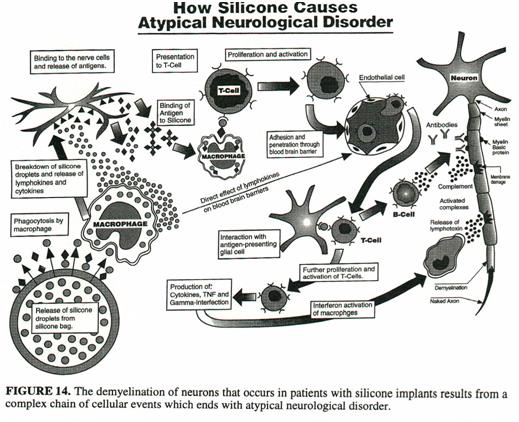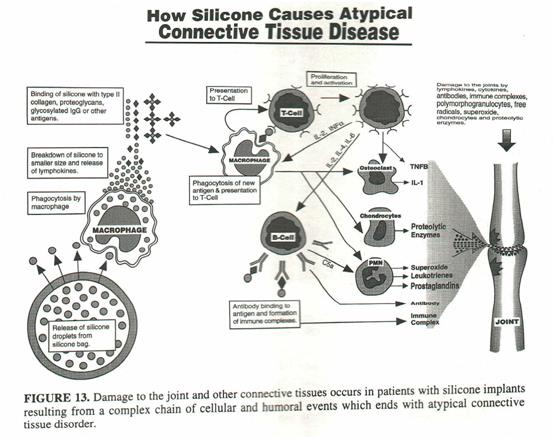
COSS
kids Nederland
Coalition of Silicone Survivors
COSSkids is onderdeel van Coalition of Silicone Survivors - Boulder Collorado USA
November 2018
How Silicone Causes Atypical Neurological Disorder

The demyelination of neurons that occur in patients with silicone implants result from a complex chain of cellular events which ends with atypical neurological disorder.
T-Cell
B-Cell
How Silicone Causes Atypical Connective Tisseu Desease

Damage to the joint and other connective tisseus occurs in patients with silicone implants resulting from a complex chain of cellular and humoral events which ends with atypical connective tisseu disorder.
De demyelinisatie van neuronen die zich bij patiënten met siliconen implantaten voordoen, resultaat van een complexe keten van cellulaire gebeurtenissen die met een atypische neurologische aandoening eindigt.
Schade aan het bindweefsel van het gezamenlijke en andere weefsels treedt op bij patiënten met siliconen implantaten als gevolg van een complexe keten van cellulaire en humorale gebeurtenissen die met atypische bindweefsel tisseu wanorde eindigt.
I
J
F
E
D
B
C
K
H
M
L
G
R
P
Q
V
U
T
S
A
N
W
O
A
B
C
D
E
F
G
H
O
M
X
L
K
J
I
Release of silicone droplets from silicone bag.
Phagocylosis by macrophage
Breakdown of silicone droplets and release of lymphokines en cytokins.
Binding tp the nerve cells and release of antigens.
Presentation to T-Cell
Binding of antigen to silicone
Proliferation and activation.
Adhesion and penetration through blood brain barrier.
Interaction with antigen-presenting glial cell.
Production of: Cytokines, TNF and Gamma-interfection.
Endothelial cell.
Futher proliferation an activation of T-Cells.
Interferonactivation of macrophages.
Naked Axon.
P
Q
R
V
U
T
S
N
Release of lymphotoxin
Activated complaxes
Complement.
X
W
E
Antibodies.
Membrane damage.
Axon.
Myelin sheet.
Direct effectof lyphokines on blood brain barriers.
Myelin basic protein.
Demyelination.
Release of silicone droplets from silicone bag.
F
D
C
B
A
J
P
O
N
L
K
I
H
G
M
A
T-Cell
B-Cell
J
B
G
I
H
F
E
D
N
M
L
K
C
P
O
Phagocytosis by macrophage.
Breakdown of silicone tosmaller size and release of lymphokines.
Binding of silicone with type II collagen, proteoglycane, glycosilated IgG of other antigens.
Phagocytosis of new antigen & presentation to T-Cell.
Presentation to T-Cell.
Damage to the joints by lymphokines, cytokines, antibodies, immune complexes, polymorphogranulocytes, free radicals, superoxide, chondrocytes and proteolytic enzymes.
Osteoclast - IL 1
TNFB
Proliferation and activation.
PMN - Superoxide - Leukotrines - Prostaglandins.
Antibody binding to antigen and formation of immune complexes.
Antibody.
Chondrocytes - Proteolytic - Enzymes
Immune complex.
Joint.








